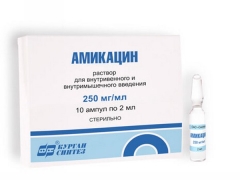Amikacin for children: instructions for use
If a child has a serious infection, the use of antibacterial drugs is indispensable. One of the most effective is Amikacin. Is it possible to treat children with such an antibiotic, how to dilute the medicine correctly and how can its use harm the children's body?
Release form
Amikacin is produced in the form of a solution and in powder, but at the same time the medicine is packaged in ampoules and vials. Suspension, Amikacin capsules or tablets do not exist, so drinking this medicine will not work.
Amikacin powder form is represented by vials of 250, 500 or 1000 mg of the active substance. Ampoules with water for injection of 2 or 5 ml can be attached to them.
Ampoules with Amikacin solution are represented by a dosage of 250 mg of the antibiotic in 1 ml, and the ampoules themselves contain 2 or 4 ml of liquid. Also, the drug can be purchased in ampoules with a capacity of 2 ml, where the active substance contains 100 mg or 500 mg.
Composition
In vials of powder, only the active substance is present. The injection solution contains not only amikacin, but also sodium citrate, water, sulfuric acid and sodium disulfite.
Operating principle
Amikacin is a drug that is classified as antibiotic aminoglycoside. It is also an effective anti-TB drug. After entering the body, this antibacterial drug penetrates the cell membranes of pathogens, and then binds to the intracellular components of bacteria and disrupts protein synthesis in microbial cells. As a result, the bacteria die, so the action Amikacin called bactericidal.
The range of activity of Amikacin against microorganisms is quite wide.
This medicine effectively fights against:
- Pseudomonads.
- Intestinal sticks.
- Klebsiella.
- Enterobacter.
- Shigella.
- Streptococcus.
- Salmonella.
- Staphylococcus.
- Serratia.
- By the Providences.
- Mycobacteria.
Amikacin quite often helps with resistance to other antibacterial agents, for example, to penicillin, gentamicin or isoniazid. Resistance to such a drug develops quite rarely (more than 70% of microbes remain sensitive to it).
The drug is almost not absorbed and quickly destroyed in the digestive tract, so it is injected in the form of injections. The maximum concentration of Amikacin is reached in the patient's body in 30-60 minutes, then it drops to therapeutic and lasts for about 10-12 hours. Amikacin penetrates tissues easily and can have an effect on bones, brain, lungs, heart muscle and other organs.
Indications
The reason for prescribing Amikacin can be various infectious diseases.
This medicine is prescribed:
- With pneumonia, bronchitis, abscesses in the lungs or bacterial lesions of the pleura.
- With endocarditis (subacute and acute forms).
- With tuberculosis.
- When gonococcal infection.
- With purulent otitis.
- When caused by bacteria, meningitis and other infections of the central nervous system.
- With intestinal infections.
- With peritonitis and other microbial lesions of the abdominal cavity.
- With cholangitis.
- In infectious lesions of the subcutaneous tissue and skin.
- When bacteria provoked myositis, bursitis or arthritis.
- With osteomyelitis.
- In infectious inflammation of the urinary tract.
- With chemical or thermal burns.
- In case of eye diseases (medication is applied topically).
- With postoperative infections.
- With sepsis.
At what age is it allowed to take?
Instructions for use for children allows the possibility of prickling Amikacin from birth, however For newborn babies, this medicine is injected very carefully. Special attention also requires the appointment of the drug to a premature infant.
Amikacin should be prescribed to children of any age only by a doctor, because the use of this drug has its own precautions. In addition, the doctor will be able to accurately calculate the required dose, since babies in 3 years need a completely different amount of medication than children 8 years or older.
Contraindications
Amikacin is contraindicated in cases of intolerance to this drug, as well as hypersensitivity to other antibiotics from the group of aminoglycosides.
Also this medicine is not given:
- If you have problems with hearing or vestibular apparatus.
- When neuritis auditory nerve.
- If kidney function is impaired, for example, tests have shown azotemia, uremia, or renal failure.
- With severe heart disease.
- With serious diseases of the blood-forming organs.
The drug is used very carefully, if the patient is dehydrated. This medication is prescribed to pregnant women only in the presence of vital indications, because Amikacin penetrates the placenta and can adversely affect the hearing and kidneys of the fetus. The drug also enters human milk, so with breastfeeding Amikacin do not combine treatment.
Side effects
Amikacin has a negative effect on 8 pairs of cranial nerves, especially if the patient is dehydrated or the kidneys are impaired. Therefore, taking such medication often provokes a feeling of congestion in the ears, noise, hearing loss, and a high dosage can lead to irreversible deafness.
This antibiotic has a nephrotoxic effect. Its reception can lead to hematuria, oliguria, urinary protein excretion, as well as renal failure. In addition, the drug has a negative effect on the sense of balance. The patient after treatment with Amikacin may feel dizzy and lose coordination of his movements.
Other side effects of Amikacin therapy are:
- Headaches.
- Hand shake.
- Muscle twitching.
- Paresthesia.
- Lowering blood pressure.
- Palpitations.
- Anemia.
- Nausea.
- Dysbacteriosis.
- Diarrhea.
- Itching of the skin, urticaria and other allergic reactions.
- Vomiting.
- Pain at the injection site.
- Inflammation of the skin.
- Fever.
- Inflammation of the vein with intravenous injection.
Instructions for use and dosage
- Before treatment with Amikacin, it is recommended to make an analysis of the sensitivity of the pathogen to this medicine.
- Amikacin can be administered to a child intramuscularly or intravenously. The medication is injected into a vein either slowly in a stream (about two minutes) or in a droplet manner (about 60 drops in one minute).
- The solution for injection of Amikacin powder should be prepared immediately prior to injection. In a bottle with 0.25 or 0.5 g of the drug for intramuscular injection, add 2 or 3 ml of special water for injection. To make an intravenous infusion, the contents of the vial are diluted in 200 ml of glucose or saline so that a solution with a concentration below 5 mg / ml is obtained.
- It is not recommended to combine Amikacin solution with any other drugs in the same infusion system or in the same syringe in order not to provoke the appearance of inactive complexes.
- During Amikacin therapy, the kidneys should be monitored (they determine the level of urea and creatinine in blood tests) and the state of the pre-cochlear nerves (they make an audiogram).
- Calculate the dose of Amikacin should be based on the weight of the child.Treatment begins with a single dosage of 10 mg per kg of body weight, and then increased to 15 mg / kg per day. This daily dose is divided into 2 or 3 doses, that is, a child is given 7.5 mg / kg of the drug every 12 hours or 5 mg / kg every 8 hours. For example, if a child weighs 22 kg, then for the first injection he needs 220 mg of the drug, and then the drug should be administered twice a day, 165 mg, or three times a day, 110 mg.
- The course of treatment with Amikacin lasts from 3 to 7 days if the drug is injected into a vein, and 7-10 days if intramuscular administration is used. If treatment within 5 days did not bring effect, replace the antibiotic.
Overdose
Excess doses of amikacin can cause a toxic reaction in a patient. The drug causes a neuromuscular blockade, which can lead to respiratory failure. If the drug is administered in too high a dosage to the infant, this leads to depression of the nervous system. The child becomes lethargic, may fall into a coma and stop breathing.
For the treatment of overdose, atropine, calcium chloride, anticholinesterase drugs and other symptomatic drugs are administered to the patient. If the condition is very bad, blood transfusion and mechanical ventilation are indicated.
Interaction with other drugs
- Amikacin has an incompatibility with many other drugs. Among the drugs that should not be prescribed with such an antibiotic, called heparin, penicillins, erythromycin, vitamins of group B, potassium chloride, cephalosporins, ascorbic acid and some other medicines.
- If Amikacin is used together with other aminoglycosides or after a course of any of the antibiotics of this group, the antimicrobial effect of the drug will be less pronounced, and the toxic effect will increase.
- The nephrotoxic effects of amikacin may be increased with the simultaneous administration of this drug and vancomycin, amphotericin B, polymyxin, nalidixic acid or cephalothin.
- If Amikacin is prescribed together with loop diuretics, for example, furosemide, this will increase the negative effect of the antibiotic on hearing.
- If Amikacin injections are combined with magnesium sulfate, narcotic analgesics, inhalation anesthesia, polymyxins or curariform drugs, this will lead to increased neuromuscular blockade.
Terms of sale
Buying a drug is available only with a prescription.
Storage conditions and shelf life
The place where Amikacin ampoules or vials will be stored should be protected from light and out of reach of children. Storage temperature should not exceed +25 degrees. Shelf life of the drug is 3 years.
Reviews
Most of the reviews on the use of Amikacin in children are positive. Parents note that the medicine helps the sick child very effectively and quickly (after the first injection). In pediatrics, this medication is most often prescribed for intestinal infections.
The main minus intramuscular injections Amikacin called quite pronounced their paintherefore, many doctors, instead of water for injections, are allowed to dilute the drug with novocaine. This reduces the discomfort of injections.
Analogs
Instead of Amikacin, you can use other drugs with the same active substance, for example, Hemomycin, Fartsiklin or Amikin. Other aminoglycosides, such as Netilmicin or Tobramycin, can also be used in place of Amikacin. At the same time, if Amikacin needs to be replaced with another antibacterial agent, for this it is worth knowing the sensitivity of bacteria to other antibiotics.
























